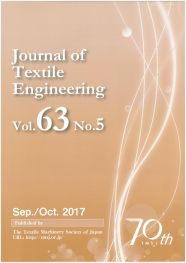
- Issue 6 Pages 149-
- Issue 5 Pages 121-
- Issue 4 Pages 93-
- Issue 3 Pages 63-
- Issue 2 Pages 33-
- Issue 1 Pages 1-
- |<
- <
- 1
- >
- >|
-
Tomoe MASUDA2017 Volume 63 Issue 5 Pages 121-129
Published: October 15, 2017
Released on J-STAGE: May 01, 2018
JOURNAL FREE ACCESSThis study examined the significant factors involved in a custom-made garment creation system used for 3D fitting and 2D patterns for skirts. 3D tight-fitting skirts were developed from 3D imaginary skirt forms simulated by constructing individual 3D body shapes using a convex hull. The features of the 3D curved tight-fitting skirt surface shapes of 1,044 females were extracted by means of the angle curvatures of the triangle mesh 3D skirt shapes to yield information that can support communication between retailers and their consumers. There are deficit angles of concentrated Gaussian curvature Kc on interior area vertexes and concentrated geodesic curvature kc on the exterior boundary waistline and hemline vertexes. We identified the features of the 3D tight-fitting skirt curved surface shape, including the presence of darts, for a considerable number of female for 2D pattern generation, regardless of the body size and without using cloth or having to sew a skirt. We then classified the 3D tight-fitting skirt curved surface shapes based on the features of the areas, including the female ages. A viable virtual reality custom-made tight-fitting skirt creation system was established to support the development of an eco-clothing lifestyle and to provide the information needed for the project to succeed.
View full abstractDownload PDF (2158K) -
Tomoe MASUDA, Minami WADA, Hiroko YOKURA2017 Volume 63 Issue 5 Pages 131-139
Published: October 15, 2017
Released on J-STAGE: May 01, 2018
JOURNAL FREE ACCESSThe 3D curved surface shapes of tight and flared skirts were predicted precisely by the angle curvatures (concentrated Gaussian curvature Kc, concentrated geodesic curvature kc, and concentrated mean curvature Hc), model sizes, skirt designs, and fabrics. All of the 72 skirts, encompassing 3 female body models (mean body sizes of Japanese women in their 20s, 40s, and 70s), 6 kinds of fabrics, tight skirts, and 3 kinds of flared skirts, were investigated with attention to the differences of the curved surface shapes in detail. It has been found that it is possible to predict the number of nodes on hemlines for these 72 skirts with the three totalized feature factors, |Σ±Kc|+|Σ±kc|, |Σ±Hc|, and weight (g/cm2) × hemline length (cm), underlying the physical properties of fabric and model sizes, based on slightly high or high correlation coefficients (r = 0.73 to r = 0.93). Therefore, the number of nodes on hemlines of these 72 skirts can be calculated by these three totalized feature factors using a multiple regression analyzing technique, (multiple regression coefficient R = 0.96), based on higher prediction accuracy.
View full abstractDownload PDF (4117K) -
Hiroki MARU, Yuichi NAGASHIMA, Hiroyuki KANAI, Toyonori NISHIMATSU2017 Volume 63 Issue 5 Pages 141-148
Published: October 15, 2017
Released on J-STAGE: May 01, 2018
JOURNAL FREE ACCESSMost of previous researches on fabric texture have been focused on the aspect of fabric hand in comparison with that of fabric appearance. However in a few of previous researches mentioned an existence of multisensory interaction among the fabric hand and fabric appearance on the evaluation of fabric texture. Thus we have here attempted to conduct the evaluation of the fabric hand via the tactile system and that of the fabric appearance via visual system respectively. And clarified the commonality on these evaluation, in order to investigate the occurrence of the multisensory interaction, especially the occurrence of the acceleration or the inhibition affect. As a result, the high commonality was observed among these evaluation on feature of warmness and softness. But no commonality was observed on feature of roughness and moistness. In addition, the identification of triggering character which induced the evaluation on fabric hand or fabric appearance was investigated for feature of warmness, softness, roughness and moistness, respectively. Finally, it was considered that the multisensory interaction, especially the acceleration affect, is expected to occur among evaluation of fabric hand and fabric appearance on feature of warmness and softness. And the multisensory interaction, especially the inhibition affect, is also expected to occur on feature of roughness and moistness, respectively.
View full abstractDownload PDF (1194K)
- |<
- <
- 1
- >
- >|